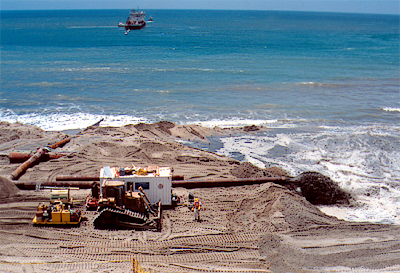
 After months of negotiation, Congress has passed an updated Water Resources Development Act (“WRDA”) which authorizes coastal restoration and engineering projects by the Army Corps of Engineers. While the legislation will support many important restoration projects, it also includes provisions to reduce environmental and public review, and may allow for indefinite extension of beach fill projects. On a more positive note, the bill excludes an amendment that would have obstucted the National Ocean Policy and also contains a new program to advance ocean and coastal resiliency.
After months of negotiation, Congress has passed an updated Water Resources Development Act (“WRDA”) which authorizes coastal restoration and engineering projects by the Army Corps of Engineers. While the legislation will support many important restoration projects, it also includes provisions to reduce environmental and public review, and may allow for indefinite extension of beach fill projects. On a more positive note, the bill excludes an amendment that would have obstucted the National Ocean Policy and also contains a new program to advance ocean and coastal resiliency.
Surfrider chapters across the country worked hard to improve the final version of the bill through outreach to their legislators. For more background on WRDA including a summary of the pros and cons please see below:
What is WRDA?
The Water Resources Development Act is federal legislation that provides the main vehicle for authorizing projects—for navigation, flood control, hydropower, recreation, water supply, and emergency management—to be studied, planned and developed by the United States Army Corps of Engineers. The law does not appropriate funds for those projects and programs, however. It authorizes the projects, but the appropriation of funds must be addressed in subsequent legislation. It is a very important piece of legislation that can have a dramatic impact on your favorite beach or surf spot because WRDA funds the U.S. Army Corps of Engineers. Almost every coastal community in America is somehow affected by a Corps of Engineers project. The Corps of Engineers are responsible for many coastal armoring and beach fill projects, channel dredging for navigation, construction of dams and flood control projects, and wetlands alterations to name a few. You can learn more about WRDA's history on Beachapedia.
The Good
WRDA is a crucial piece of legislation that supports many important coastal restoration projects. These projects can provide significant benefits to communities and, in some cases, help restore ecosystem function. In addition, the final version of the bill excludes an amendment by Rep. Bill Flores that would have obstructed National Ocean Policy (NOP) implementation by blocking the U.S. Army Corps of Engineers from participating in any NOP efforts including regional ocean planning (For more on Rep. Flores' attacks on the NOP click here). Finally, the bill includes a new program created by Senator Sheldon Whitehouse to advance ocean and coastal resiliency. The program, when funded, will authorize the Army Corps of Engineers to conduct a study once every five years – in coordination with states, nonprofit organizations, and other stakeholders – to determine the feasibility of projects in coastal zones to enhance ocean and coastal ecosystem resiliency. Through the study, the Army Corps will identify specific projects to carry out. Eligible projects could potentially include efforts to:
- Make beaches more resilient to coastal erosion;
- Restore wetlands that serve as important buffers to protect coastal property from storm surges;
- Carry out planning initiatives to help ecosystems adapt to sea level rise.
The Bad
In an effort to speed up approval and construction of projects the bill contains environmental streamlining provisions that strike at the heart of the laws that provide for meaningful agency and public engagement in Corps projects. The provisions let the Corps set their own timelines for federal agencies to provide reviews of impacts to natural resources, and can fine those agencies if they miss deadlines. This will make it difficult for those resource experts to raise legitimate issues about Corps projects. The streamlining also could put the Corps in charge of endangered species reviews, instead of the US Fish and Wildlife Service, in an effort to expedite project delivery. Public safety, the environment, and taxpayers require reviews that carefully evaluate the full impact of Corps projects and rely on the ability of the expert resource agencies to raise concerns and objections free from undue pressure. The National Environmental Policy Act and coordination with agencies like the U.S. Fish and Wildlife Service disclose the true environmental and economic costs of Corps projects and allow decision makers and the public to determine whether those projects are deserving of investment by federal taxpayers. They produce better, less damaging projects and have prevented fundamentally ill-conceived projects from advancing. This has saved hundreds of millions in taxpayer dollars while protecting wetlands vital to flood protection, migratory waterfowl, and clean water. In the face of increasing fiscal challenges, severe storms, floods, droughts, and sea level rise, we simply cannot afford to undermine these critical safeguards.
